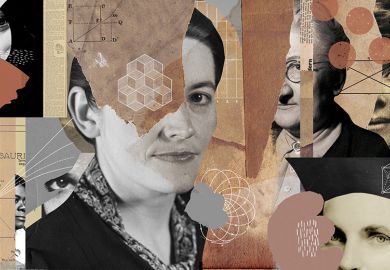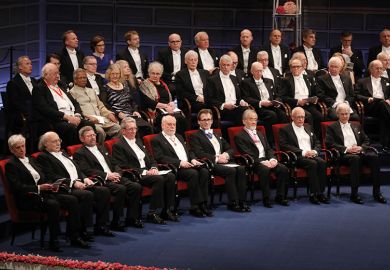Winning a Nobel prize is, to put it mildly, a pretty remarkable achievement.
But when Christiane Nüsslein-Volhard was awarded her Nobel in 1995, jointly with Edward Lewis and Eric Wieschaus, it was a remarkable achievement in more than one way. She became only the sixth woman since 1901 to be awarded the Nobel Prize in Physiology or Medicine. Nobel prizes for chemistry and physics are even rarer.
As a fresh physics undergraduate watching the news on television, I should have calculated that the probability of my ever being awarded that highest of scientific honours was minuscule and opted for a career in finance.
But no, the “curiosity” bug had already bitten me. That same bug afflicts most scientists around the world, causing them to wake up every morning grinning at the prospect of spending a whole day in the laboratory trying to add a tiny tile to the mosaic of scientific endeavour.
Christiane Nüsslein-Volhard, who is certainly afflicted by the bug, had embarked on a particularly heroic quest to answer the almighty question of how a unicellular embryo develops into a multicellular organism. Her Nobel prize award was, for me, like for many other scientists of my generation, a source of inspiration.
It instilled in me the belief that when it comes to science no question is too bold, no pursuit too daring.
I devoured Christiane’s biography to learn how the bulk of her and Wieschaus’ award-winning research had been carried out in the late 1970s at the European Molecular Biology Laboratory (EMBL).
As a physicist yearning to learn more, the truly international and interdisciplinary atmosphere that you could breathe in the EMBL Heidelberg headquarters, where I followed in Christiane’s footsteps in 1996, was intoxicating. Despite leaving EMBL in 1981, Christiane’s powerful legacy remained for future generations of EMBL scientists.
Knowing that Nobel prize-worthy, paradigm-shifting research had been carried out in that tiny laboratory, the first on the left on the fourth floor of the main building, made us all the more enthralled with our science. Christiane’s achievement of identifying and classifying the 15 genes that direct the cells to form a new fly is also remarkable given the tools that were available to her and Eric in the late 1970s.
The Drosophila melanogaster genome sequencing project was completed only in March 2000. Her experiments were conducted without molecular cloning, genome sequencing and proteomics – all techniques that today are a basic requirement for this field.
The general relevance of her research to higher organisms and humans was evident only in the mid-1980s, when it was made clear that the gene cluster she uncovered is conserved in organisation and function in all animals that develop from embryos.
Her sheer determination, visionary instinct and ability to challenge the status quo remain awe-inspiring to this day. And yes, her achievements are remarkable also because she is a woman.
When, in 1964, Dorothy Crowfoot Hodgkin was awarded the Nobel Prize in Chemistry, The Observer wrote that the "affable-looking housewife Mrs Hodgkin" had won the prize "for a thoroughly unhousewifely skill: the structure of crystals of great chemical interest".
Hodgkin famously said in her Nobel banquet speech: “I was chosen to reply to you this evening as the one woman of our group, a position which I hope very much will not be so very uncommon in future that it will call for any comment or distinctions of this kind, as more and more women carry out research in the same way as men.”
Sadly, that has not exactly come to fruition. Between 1901 and 2016, only 18 female scientists were awarded a Nobel, compared with 572 male scientists. Dorothy would not be impressed.
Even though more and more women carry out research, it would be naive to deny that a glass ceiling remains for women in science. As long as that ceiling is there, we will leak precious talent through the scientific career pipeline.
Initiatives such as the Athena Swan Charter have started a frank discussion on this topic but precious little practical work has been done to materially fix the leaking pipe.
In Germany, Christiane’s vision encompasses a legacy for future generations. In 2004, she established the Christiane Nüsslein-Volhard Foundation, which financially supports talented young women with children and aims to increase the number of women in senior research positions.
Christiane herself recognises that financial support alone will not solve this. In other areas of human endeavour such as sport, women are celebrated (and sponsored). Sadly, female scientists do not have the same social standing and yet we still do not fully acknowledge the social biases that obscure and downplay women's scientific achievements.
While this remains the case, it will be difficult to encourage young women to make the necessary sacrifices for a role that might not be fully accepted by society. This is why female role models in science, such as Christiane Nüsslein-Volhard and Dorothy Hodgkin, should be held up high to inspire new generations.
Listening to Christiane’s speech that winter of 1995, I was inspired to become a scientist. And while it is true that I am still awaiting that Nobel prize, I was at the University of Sussex Life Sciences Symposium presenting my data in the same session as Christiane. And that is no small achievement…chin up, girl!
Erika Mancini is a reader in biochemistry at the University of Sussex. She attended EMBL between 1996 and 2000. Christiane Nüsslein-Volhard joined fellow Nobel prizewinner Sir Venki Ramakrishnan as special guest speakers at the University of Sussex's annual Life Sciences Symposium on 14 September.
POSTSCRIPT:
Print headline: The enduring inspiration of a female Nobel winner helps chip away at the glass ceiling
Register to continue
Why register?
- Registration is free and only takes a moment
- Once registered, you can read 3 articles a month
- Sign up for our newsletter
Subscribe
Or subscribe for unlimited access to:
- Unlimited access to news, views, insights & reviews
- Digital editions
- Digital access to THE’s university and college rankings analysis
Already registered or a current subscriber?









